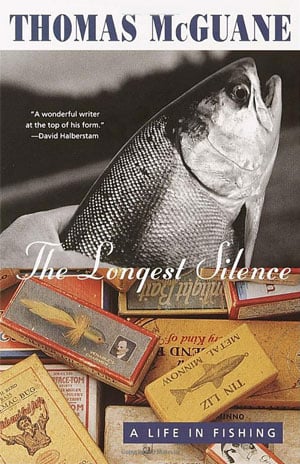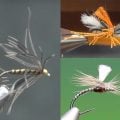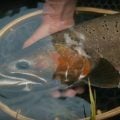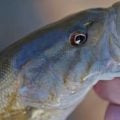The Longest Silence
Small Streams in Michigan
THE FIRST FLY ROD I ever owned was eight feet of carpet beater made by a company whose cork grips were supplied by my father. My father worked for a Portuguese cork company whose owners swam at Estoril and supplied our family with innumerable objects of cork, including cork shoes, cork boxes, cork purses, and unidentified flying cork objects that my brother and I threw at each other. In our living room we had large cut-glass decanters of Burgundy, long soured, and my brother and I would have a couple of hits of that vinegar and head for the cellar to throw cork.
Everyone in our family had a huge brown fly rod with a Portuguese cork handle and identical Pflueger Medalist reels of the size used for Atlantic salmon. As I look back, I am touched by my father’s attempts to bring us to sport, en famille.
I remember when he and my mother canoed the Pere Marquette in that early phase. Passing underneath the branches of streamside trees, my mother seized one of them in terror. The branch flexed; the canoe turned sideways in the current and began to go under. My father bellowed to let go of the branch. My mother did and the branch shot across the canoe like a longbow, taking my father across the chest and knocking him overboard.
With his weight gone, one end of the canoe rose four feet out of the water and my mother twirled downstream until my father contrived to race along a footpath and make the rescue.
When it was done, two rods with Portuguese cork grips were gone. The canoe was saved until the time my brother and I used it as a toboggan in snow-filled streambeds and beat the bottom out of it.
At that time, we lived down on Lake Erie, where I conducted a mixed-bag sporting life, catching perch and rock bass on worms, some pike on Daredevils, some bass on a silver spoon. In the winter, I wandered around the lake on the ice and shot crows, a painful memory.
But when we went up north with our Portuguese cork handle fly rods, I knew the trout were there. And so I spurned worms, owned a fly box, and espoused purist attitudes in the traditional burst of posturing common to new fly fishers.
There was a lake near the cabin, and I would paddle out upon it trailing all my fly line and a Mickey Finn streamer. Then I would paddle around the lake, trolling that fly until I caught a trout. This is about the minimum, fly-wise. But I do remember, with a certain finality, what those trout looked like lying between the canoe’s varnished ribs, and how it felt to put the trout and jackknife on the dock in the evening, pull the canoe up on the beach, and clean my catch.
I don’t doubt that for many fine anglers the picture of what fishing could be begins with a vision of worm gobs lying in dark underwater holes, the perfect booby trap. The casters I used to see, throwing surface plugs in flat arcs up under the brushy banks, made that kind of fishing seem a myth. And once I could even see the point of fishing with outriggers. But now trout seem to be everything that is smart and perfect in fish, and their taking of a floating fly or free-drifting nymph is a culmination in sport comparable to anything. But what interests me is how I came to believe that.
I recall grouse hunting near the Pere Marquette when I was very young. It had just snowed, and I had killed one bird, which bulged warm in the back of my coat. I kicked out a few more birds in a forgotten orchard and couldn’t get a shot, then walked down a wooded hill that ended in a very small stream, perhaps two feet wide, but cut rather deeply in mossy ground. A short distance above where I stood, the stream made a pool, clear and round as a lens. In the middle of that pool a nice brook trout held in the cold current. With a precision that still impresses me, it moved from one side to the other to intercept nymphs, always perfectly returning to its holding position in the little pool.
Not long after that, during trout season, I waded the Pere Marquette one hot day on which not a single rising fish was to be found. I plodded along, flicking wan, pointless casts along the bank.
The river at one point broke into channels, and one channel bulged up against a logjam, producing a kind of pool. I had always approached this place with care because trout soared around its upper parts and if a cast could be placed very quietly on the slick bulge of water, a take was often the result. I crept up, but no trout grazed under its surface waiting for my Lady Beaverkill to parachute in.
Salvation, though, was around the corner. The deep, shadowy color of the pool seemed to hold a new glint. I stood erect. There was nothing near the top of the pool for me to spook, but clearly trout were deep within it, moving enough to send up their glints.
I remembered the brooky in the minute fissure of stream when I’d been grouse shooting, and I recalled how steadily he had held except to intercept a free-swimming nymph in the icy water. It occurred to me that something like that sudden lateral movement and return must be what was sending these messages to me from this large pool in the Pere Marquette.
I tied on an indeterminately colored nymph and shot a cast up to the head of the pool. The nymph dropped and sank, and the point of my floating line began its retreat back toward me at current speed. About a third of the way back, the line point stopped. I lifted and felt the weight. A couple of minutes later, I trapped a nice brown trout against the gravel at the foot of the pool with my trembling hands.
This was before I had learned the thrill of the release, of a trout darting from your opening hands or resting its weight very slightly in your palms underwater, then easing off. So three nice trout went from the pool into my creel and then, after a decent interval, into my mouth.
Anyway, the connection was complete. And even if I couldn’t always put it together, I saw how it was with nymphs. Years of casting and retrieving made it difficult to slackline a tumbling nymph—the forms of manipulation in trout fishing are always so remote—but I realized that fishing a nymph invisible under the pools and runs on a tensionless line was not inferior in magic to fishing a dry-fly.
Later we found a long beaver pond covering many acres of ground in a dense mixed forest of pine and conifer. I had a hunch that good-sized brook trout had migrated down from the stream and into the pond.
Beaver ponds are a mixed blessing, providing only a few years of good fishing. After that the standing water turns sour and the size of the average fish gets smaller as his head grows proportionately larger.
But this pond was only a couple of years old, with a soft bottom covered with drowned leaves. I had some trouble locating the pond but ended up tracking its source through the cedars. It was almost evening when I got there, and huge columns of light came down through the forest. There was a good hatch of mayflies in progress along the stream, with small trout rising to them and cedar waxwings overhead hovering in the swarm.
The pond was perfect. Some dead trees stood ghostlike in its middle, and the pond itself inundated small bays around the water-tolerant cedars. Best of all, big, easy rises were in numerous places, slow takes that produced an actual sucking noise.
I cautiously waded for position. The pond was so smooth that I anxiously anticipated the fall of line on its surface. I had a piece of inner tube in my shirt and I used it to thoroughly straighten my leader.
Every time I moved on the soft bottom, a huge cloud of mud arose, carried behind me and then filtered down through the beaver dam. It was a cool summer evening and I was wearing a flannel shirt; I shivered a little and tried to keep from looking up when one of the big rises opened on the pond.
I tied on my favorite fly, the Adams, a pattern that exemplifies my indecisive nature. The Adams looks a little like all bugs. It’s gray and speckly and a great salesman. My fly box is mainly Adamses in about eight different sizes. In the future, I mean to be a fine streamside entomologist. I’m going to start on that when I am much too old to do any of the two thousand things I can think of that are more fun than screening insects in cold running water.
Making a first cast on delicate water can be a problem. You haven’t warmed up and it may be your most important cast. I had the advantage on this glassy pond of being able to see a number of widely separated rises, and I felt that, at worst, I could blow off one fish and still keep my act alive for one or two more.
I looked around, trying to find a place for my backcast, stripped some line, and false-cast carefully until the instant a rise began to open on the surface. I threw and dropped the fly much closer than I deserved. I poised myself not to break the light tippet on the strike and held that attitude up to the descending moment I realized the fish wasn’t going to take. Another fish rose and I covered him, waited, and got no take.
I let the line lie on the water and tried to calm down. My loop was turning over clean and quiet; the leader was popping out straight. The Adams sat cheerily on its good hackle points. I refused to believe the fish were that selective. Then I hung up a cast behind me, trying to cover a fish at too new an angle, and a lull set in.
You never know about lulls. You ask, Is it my fault? Do the trout know I’m here? Have they heard or felt my size-twelve tread on this boggy ground? Is my casting coarse and inaccurate? Where can I buy a drink at this hour?
It was getting dark. I didn’t have a fish. The rises kept appearing. I kept casting and never got a take. There is a metallic loss of light one feels when it is all over. You press to the end but it’s kaput. I left in blackness. A warm wind came up and gave the mosquitoes new hope. I lit a cigar to keep them out of my face and trudged through the forms of the big cedars along the stream, trying not to fall. I snagged my suspenders on a bramble and snapped myself. The moon was full and I was thinking about the TV.
The next evening I was back earlier. This time I crawled to the edge of the pond with the light at my back and had a good look. The first thing I saw was the rises, as many as the night before. I remembered how they had failed to materialize then and checked my excitement. As I watched, I caught a rise at the moment it opened, then saw the fish drop beneath the ring and continue cruising until it was beyond my view. The next rise I caught, I saw another cruiser, moving immediately away from the place of the rise and looking for another insect. I began to realize my error of the night before. These were cruising fish, waiting for something to pass through their observation lane. There were a good number of them traveling about the pond, hunting for food.
I retreated from my place beside the pond, circled around below the dam and waded into my position of the night before. I tied on another Adams, this time a rather large one. I cast it straight out into the middle of the pond and let it lie.
Rises continued to happen, picking up a little as evening advanced and the cedar waxwings returned to wait, like me, for the hatch. My Adams floated in place, clearly visible, and I could see the curves of my leader in the surface skin of the water. I waited for a trying length of time. I had to see my theory through because, like many a simple-minded sportsman, I see myself as a problem solver.
The fly dropped out of sight. I didn’t respond until the ring had already started to spread, and I lifted the rod and felt the fish. The trout darted off in a half-dozen chugging didoes in the dark water over drowned leaves. I landed him a moment later, a brook trout of a solid pound. I studied him a moment and thought what a bright, lissome, perfect fish this little American char is.












